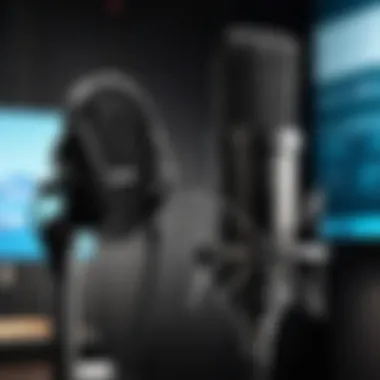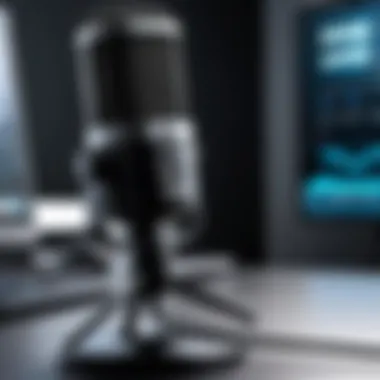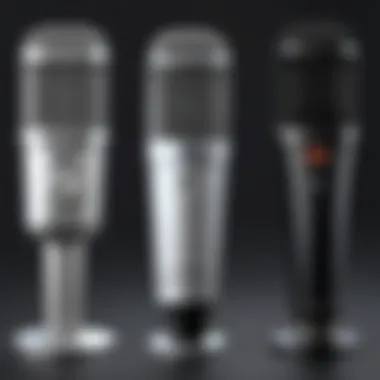Top Voice Over Microphones of 2021: Detailed Review


Intro
Choosing the right microphone for voice over work is crucial for both amateur and professional voice artists. The market offers a wide range of microphones, each tailored to specific needs and budgets. This analysis focuses on the best voice over microphones available in 2021. We will delve into important features, performance metrics, and overall suitability for various recording situations. Whether you are just starting or looking to upgrade your equipment, you will find valuable insights here.
Key Considerations
When selecting a microphone, several factors must be taken into account:
- Type of Microphone: Dynamic, condenser, and ribbon microphones each have their distinct characteristics.
- Budget: The price range can greatly affect your options. From affordable to high-end solutions, knowing your budget helps narrow the choices.
- Recording Environment: Soundproofing and room acoustics can influence microphone performance.
- Usage Purpose: Depending on whether you’re recording for podcasts, audiobooks or video content, different microphones may be more advantageous.
This guide aims to equip readers with a comprehensive understanding of available microphones, enabling informed decisions tailored to specific voice over demands.
Preface to Voice Over Microphones
Voice over microphones are a cornerstone of the audio recording industry. Their significance stretches far beyond mere sound capture; they are essential for clear and professional audio output. This section explores various aspects critical to understanding voice over microphones. Audio quality is not just a luxury; it is a necessity for anyone looking to produce content that engages listeners. Poor audio can detract from the effectiveness of a message, no matter how compelling the content may be.
Understanding the Importance of Quality Audio
Good audio quality leads to better comprehension and engagement of the audience. When audio is clear and crisp, listeners can focus on the spoken word without distractions. For voice over work, this becomes even more relevant as many applications rely heavily on spoken communication. Whether it is for commercials, animations, or video games, the clarity of the recording directly impacts the success of the project. High-quality microphones capture the nuances of voice, providing a faithful reproduction that listeners appreciate. Poor quality, conversely, can lead to misunderstandings and a tarnished professional image.
Additionally, quality can affect the post-production process. High-fidelity recordings reduce the time spent on editing, allowing producers to focus more on the creative aspects rather than fixing audio issues.
"Quality audio remains a vital aspect of effective communication in any medium. It sharpens the message, leaving a lasting impact on the audience."
Voice Over Applications and Their Needs
Understanding the myriad applications of voice over work is key to choosing the right microphone. Each application comes with its own set of requirements. For instance, narrative voice overs require different qualities than commercial advertisements or audiobooks.
- Commercials: The sound should be energetic and captivating to hold the audience's attention.
- Audiobooks: A more subtle and warm tone is preferred, allowing for long periods of listening without fatigue.
- Video Games: Different character voices might require varied microphone characteristics to bring them to life.
- Animation: Often needs a wide range of tones and emotions, requiring flexible microphone options.
Each application underlines the need for a microphone that can adapt to different vocal styles and recording environments. Identifying specific requirements helps in selecting the most suitable equipment, ensuring that the final output meets industry standards and personal expectations.
Microphone Types Explained
Understanding the types of microphones available is essential for anyone considering voice over work. Each type has unique characteristics that can significantly influence the sound quality, application, and overall user experience. The choice of microphone can dramatically affect the final product, making knowledge of these types vital.
Dynamic Microphones
Dynamic microphones are known for their durability and versatility. They use a diaphragm attached to a coil of wire that sits in a magnetic field. When sound waves hit the diaphragm, it causes the coil to move, generating an electrical current which is then converted into audio signals. This design makes dynamic microphones particularly resistant to moisture and physical handling, making them suitable for live settings.
Dynamic microphones tend to excel in high-volume environments, which is beneficial for capturing sound in untreated spaces. Their limited frequency response often means they are not as sensitive as other types. For voice over work, they may present a challenge in capturing subtle vocal nuances. However, the Shure SM7B is a popular choice in this category, often favored by professionals for its robust build and reliable performance.
Condenser Microphones
Condenser microphones operate differently. They use a capacitor that requires both a diaphragm and an accompanying back plate. When sound waves hit the diaphragm, the distance between the two changes, which in turn varies the capacitance and creates an electrical signal. The sensitivity and wide frequency response of condenser microphones allow for a much more detailed and nuanced sound capture, which is typically preferable in studio settings.
These microphones come in two types: large diaphragm and small diaphragm, each suited for different contexts. For voice work, large diaphragm condensers like the Audio-Technica AT2020 or Rode NT1-A are often chosen for their warmth and clarity. They perform well in treating recordings and can capture the richness of the human voice effectively.
Ribbon Microphones
Ribbon microphones represent an older technology, characterized by a thin metal ribbon placed in a magnetic field. They are known for their unique tonal qualities, particularly their natural and smooth sound reproduction. Ribbon microphones typically have a figure-8 polar pattern, capturing sound from the front and rear while rejecting off-axis noise. This makes them ideal for controlled recording environments.
While not as durable as dynamic and condenser microphones, modern ribbon microphones like the AEA R84 have improved significantly in terms of durability and sound quality. Their smooth high-frequency response is especially appealing for voice over applications, bringing out a rich tonal palette that enhances vocal performances. However, caution is necessary during handling and transportation due to their sensitivity.
Top Contenders for Best Voice Over Microphone in
When selecting a voice over microphone, it is crucial to consider various factors. This section focuses on the best options available in 2021, highlighting how each contender meets specific audio needs. The right microphone can vastly improve sound quality and clarity, making the listener's experience more enjoyable. Features such as design, frequency response, and price play a significant role in decision-making. The microphones presented here are top choices based on performance, reputation, and versatility.
Shure SM7B
Specifications


The Shure SM7B is a dynamic cardioid microphone. It has a frequency response ranging from 50 Hz to 20 kHz. This broad range ensures it can capture a variety of vocal tones accurately. Its built-in air suspension system reduces mechanical noise, which improves recording quality. The microphone's sensitivity is rated at -59 dBV, which allows it to pick up quieter sounds well. This characteristic is why the SM7B is favored in many professional settings.
Pros and Cons
One major advantage of the Shure SM7B is its durability and robust design. This microphone is built to withstand frequent use without losing its quality. Additionally, the SM7B performs excellently in untreated rooms, making it a viable option for home studios. However, some may find its sensitivity requires a preamp for optimal gain, which could be an added expense.
Best Use Cases
The Shure SM7B is ideal for voice over work due to its natural sound profile. It suits various applications, including podcasts, radio announcements, and audiobooks. Its versatility allows it to handle different vocal styles, making it a favorite among voice artists and broadcasters.
Audio-Technica AT2020
Specifications
The Audio-Technica AT2020 is a popular condenser microphone known for its affordability. It features a frequency response of 20 Hz to 20 kHz, providing detailed audio capture across the entire spectrum. This microphone has a maximum SPL of 144 dB, allowing it to handle loud sounds without distortion. Its low self-noise rating is a significant benefit for clear audio recording.
Pros and Cons
This microphone is praised for its excellent sound quality, especially given its price point. The AT2020 is suitable for beginners entering voice over work as it offers professional-grade audio. However, it may require a power source, such as phantom power, which can be a drawback for users with limited equipment.
Best Use Cases
The Audio-Technica AT2020 works well for voice over, podcasting, and home recording. It is particularly effective in studio settings where background noise is minimal. This microphone can also be used for instruments, adding to its versatility.
Rode NT1-A
Specifications
Rode NT1-A is known as one of the quietest studio microphones available, with a self-noise of only 5 dBA. It captures a wide frequency range of 20 Hz to 20 kHz, ideal for detailed recording. The NT1-A has a high SPL of 137 dB, making it capable of handling various sound sources. This microphone is designed with a cardioid pickup pattern, reducing background noise effectively.
Pros and Cons
The NT1-A's low self-noise is a significant advantage for voice over work, ensuring clarity in recordings. Its build quality is also notable, designed to withstand regular use. However, some users may find its sensitivity captures unwanted noise, which could affect recordings in less controlled environments.
Best Use Cases
This microphone is perfect for studio recording, voice overs, and vocals. Its ability to capture intricate details makes it a favorite among singers and podcasters alike. It works exceptionally well in a sound-treated space, maximizing its potential.
Neumann U87
Specifications
The Neumann U87 is a renowned studio microphone favored by professionals. It features a frequency response from 20 Hz to 20 kHz and offers three polar patterns: omnidirectional, cardioid, and figure-eight. This versatility makes it adaptable to different recording scenarios. The U87 has a maximum SPL of 123 dB and a self-noise of 12 dBA, ensuring it captures voice clearly and accurately.
Pros and Cons
The U87 is often considered the industry standard for recording due to its rich sound quality and reliability. Its versatile polar pattern selection allows for flexibility in recording environments. However, it comes with a high price tag, making it less accessible for beginner users.
Best Use Cases
The Neumann U87 is an excellent choice for professional voice over work, including film, television, and commercial recordings. Its reputation in the industry makes it a preferred option for high-end projects with discerning audio requirements.
Sennheiser MK4
Specifications
The Sennheiser MK4 is a large-diaphragm condenser microphone with a frequency response of 20 Hz to 20 kHz. It can handle a maximum SPL of 140 dB, making it suitable for karaoke, studio recordings, and live performances. The MK4 features a cardioid polar pattern, reducing background noise effectively.
Pros and Cons
This microphone is known for its warm sound and good transient response, which benefits vocal recordings. It is positioned at a mid-range price point, making it affordable for many users. One downside is that the MK4 may be less ideal for untreated rooms due to its sensitivity capturing unwanted sounds.


Best Use Cases
The Sennheiser MK4 works well for voice overs, singing, and instrument recordings. Its quality sound makes it suitable for various applications, ensuring clarity and warmth in recordings.
Key Features to Consider
Understanding the key features of voice over microphones is crucial for making informed purchasing decisions. The selection of a microphone can greatly influence the quality of audio captured. Therefore, recognizing the specific attributes that contribute to superior performance is essential for both novice and experienced users. In this section, we will discuss the elements that should be taken into account when evaluating a microphone for voice over applications.
Frequency Response
Frequency response is a term that describes the range of frequencies a microphone can capture. It is usually measured in Hertz (Hz) and displayed as a graph showing the microphone's output level across various frequencies. Different voice types and recording situations may require varying frequency responses.
For voice over work, microphones with a frequency response that emphasizes the mid-range frequencies can enhance clarity. A good frequency response usually falls between 20 Hz and 20 kHz. However, certain microphones are designed to highlight specific ranges. For instance, a microphone with a boosted response in the range of 80 Hz to 15 kHz can be beneficial for vocals. This range helps in capturing the warmth and detail of a voice, making it more lively and engaging.
When choosing a microphone, consider how the frequency response fits your voice type. If you have a deeper voice, you may want a microphone that can effectively reproduce lower frequencies. Conversely, if your voice is higher in pitch, a flat or slightly boosted response in the high frequencies could provide better results.
Polar Patterns
Polar patterns determine how microphones pick up sound from different directions. Understanding polar patterns is critical in controlling background noise and achieving clear recordings. The most common polar patterns include cardioid, omnidirectional, and bidirectional.
- Cardioid: This pattern captures sound primarily from the front. It effectively rejects noise from the sides and rear, making it ideal for voice over applications in untreated rooms. Cardioid microphones are often preferred for their ability to isolate the main sound source.
- Omnidirectional: These microphones pick up sound equally from all directions. They are useful in situations where room ambiance is desired. However, they can also capture unwanted background noise, making them less ideal for isolated voice recordings.
- Bidirectional: As the name implies, this pattern captures sound from the front and back, while rejecting sound from the sides. They are often used in interviews where two speakers are positioned face-to-face.
Sensitivity and SPL Handling
Sensitivity refers to how well a microphone converts sound waves into electrical signals. It is often measured in mV/Pa (millivolts per Pascal). Higher sensitivity means the microphone can pick up softer sounds more effortlessly. This is particularly useful in voice over work where subtle nuances in speech can be important.
SPL, or Sound Pressure Level, represents the maximum volume level a microphone can handle before distortion occurs. A microphone with a higher SPL rating can capture louder sounds without degrading quality.
When selecting a microphone, consider the type of voice you have and the environments in which you will record. If you will be recording in a loud environment, prioritizing SPL handling may be more critical. Likewise, if your work involves softer, more delicate vocals, sensitivity should take precedence.
Budget vs. Premium Options
When it comes to selecting a voice over microphone, understanding the distinction between budget and premium options is crucial. This section examines how these categories influence the decision-making process for potential buyers, particularly in audio quality, durability, and overall performance.
Budget microphones typically appeal to new voice over artists or casual users. They allow individuals to enter the voice over industry without a significant financial commitment. These models are usually more accessible, meaning they can be found in various retail outlets and online.
However, the trade-off is often in quality. Budget options may deliver satisfactory results for amateur recordings but may fall short when used in professional environments. It is essential for buyers to assess their recording needs carefully before investing. The long-term effectiveness of a microphone often justifies spending a bit more.
In contrast, premium microphones are designed with advanced technology. They regularly provide superior sound clarity and frequency response. For producers and professional voice actors, these microphones contribute to high-quality recordings that meet industry standards. They generally integrate better construction materials, ensuring longevity even with regular use.
Ultimately, the choice between budget and premium microphones depends on specific user needs and aspirations within the voice over field. The investments in more expensive models may yield returns in quality that are worth considering.
Assessing your Budget
When evaluating your budget, begin by determining how often you will use the microphone. For occasional users or hobbyists, investing in a high-end microphone might not be necessary. However, frequent professionals might need a more reliable option that can withstand the rigors of regular use.
Gather the following considerations while assessing your budget:
- Purpose of Use: Understand whether you seek a microphone for personal projects, amateur recordings, or commercial work.
- Duration of Investment: Consider whether you view the microphone as a temporary solution or a long-term investment.
- Additional Equipment: Assess if you'll need to purchase related gear, such as audio interfaces or soundproofing materials.
These factors influence how much one should spend on a microphone.
Performance Expectations
Expectations regarding performance significantly impact the buyer's choice between budget and premium microphones.
For budget microphones, the following are common expectations:
- Adequate Sound Quality: Users often expect reasonably clear recordings suitable for non-professional projects.
- Simplicity: Budget models usually feature basic functionalities, making them easy to use for non-Tech-savvy individuals.
On the other hand, premium options should meet higher performance expectations:


- Exceptional Sound Clarity: They should capture a broad spectrum of frequencies, ensuring crystal-clear audio.
- Durability and Reliability: Premium microphones often feature sturdy build quality, capable of handling frequent use.
Additional Equipment for Voice Over Work
While selecting the best microphone is essential for achieving high-quality voice audio, the additional equipment you use also plays a significant role in the production process. Knowing this equipment aids in maximizing the performance of your chosen microphone. Investing in the right accessories can help minimize sound interference, enhance recording clarity, and ultimately improve overall audio output. This section discusses two critical pieces of additional equipment: audio interfaces and pop filters, along with shock mounts.
Audio Interfaces
An audio interface transforms the analog signal from a microphone into a digital format that a computer can understand. It serves as a bridge between your microphone and recording software. When selecting an audio interface, consider specifications such as sample rate, bit depth, and connectivity options. A high-quality interface enhances sound quality and reduces latency, which is vital for live performances or real-time editing.
Key Benefits of Using an Audio Interface:
- Improved Sound Quality: A good audio interface will provide better preamps than most built-in sound cards, resulting in clearer and more professional-grade audio.
- Low Latency Monitoring: Many interfaces offer real-time monitoring capabilities, enabling you to hear what you are recording without delay, which improves the recording experience.
- Multiple Inputs: If you plan to record multiple sources at once, some interfaces include multiple inputs which facilitate simultaneous recording.
- MIDI Compatibility: Some interfaces offer MIDI capabilities which can be beneficial for those looking to integrate virtual instruments into their recordings.
Pop Filters and Shock Mounts
Two other valuable accessories are pop filters and shock mounts. A pop filter is a screen that is placed in front of the microphone to reduce plosive sounds, which are bursts of air caused by certain consonants, like "p" and "b." This accessory improves clarity by preventing these sounds from overloading the microphone.
Benefits of Using a Pop Filter:
- Enhanced Vocal Clarity: By reducing plosive noises, your spoken audio becomes clearer, making editing easier and improving the final product.
- Protects Microphone from Moisture: It can also act as a barrier that protects the microphone from saliva, thus prolonging its lifespan.
A shock mount is designed to isolate the microphone from vibrations and handling noise. This is especially important in environments where background noise is an issue.
Benefits of Using a Shock Mount:
- Minimizes Vibrations: It absorbs shocks and vibrations, ensuring that sound captured is as clean and undistorted as possible.
- Improves Stability: A shock mount provides stable positioning, allowing for consistent sound capture without unwanted noises.
Integrating these additional equipment pieces enhances your recording setup significantly. When combined with high-quality microphones, audio interfaces, pop filters, and shock mounts contribute to producing professional-level voice recordings that meet industry standards.
"Quality in sound recording is not merely a function of the microphone. It’s about creating an ecosystem that supports the desired acoustic experience."
By investing in these accessories, you can ensure that your recordings are free from distracting noises and deliver a polished final product.
Recording Techniques and Best Practices
Successful voice over recording is not just about having the right microphone. It also demands an understanding of proper techniques and practices that significantly enhance the quality of audio production. These methodologies influence the way sound is captured, processed, and ultimately perceived by listeners. By implementing effective recording techniques, users can minimize noise, maximize clarity, and achieve a polished final product. In this section, we will cover essential elements related to setup and microphone positioning, as they are crucial to obtaining the best sound possible.
Setting Up Your Recording Space
Creating an optimal recording environment is a key step before you even switch on your microphone. Begin by selecting a quiet space, free from distractions and background noise. Ideally, rooms with soft surfaces, like rugs and curtains, help absorb sound and reduce echo.
Consider these specific points when arranging your recording space:
- Noise Management: Identify potential sources of noise, such as outside traffic, appliances, or air conditioning. Close windows and doors, or use soundproofing techniques to reduce these disruptions.
- Acoustic Treatment: Installing foam panels or bass traps can assist in controlling sound reflections, creating a balanced audio environment. This is especially beneficial if your recording space has hard surfaces like tiles or glass.
- Equipment Arrangement: Position your microphone at an appropriate height and distance from where you will be speaking. Ensure all equipment is easily accessible, so adjustments can be made quickly and efficiently.
Creating an organized and controlled environment allows for a more focused recording session, enhancing your overall productivity.
Microphone Placement
The placement of your microphone can greatly affect the sound quality of your recordings. It is not just about where to put it, but also how to position it in relation to your voice. Here are some guidelines to consider when positioning your microphone:
- Distance: For most situations, keeping the microphone about 6 to 12 inches away is recommended. This distance helps avoid excessive plosives while capturing rich sound.
- Angle: Position the microphone slightly off-axis from your mouth to reduce breath sounds and plosives. A slight angle can help capture a fuller tone without the unwanted pops.
- Height: Depending on your setup, the microphone should ideally be at mouth level or slightly higher. This positioning helps in achieving clarity and ensures proper capture of vocal nuances.
"Proper microphone placement is as important as the quality of the microphone itself. It directly impacts how your voice is recorded."
Addressing these aspects of recording techniques and practices not only leads to better sound quality but also builds a more professional voice over product. Taking the time to optimize your setup and placement pays off in the clarity and richness of your audio recordings.
Epilogue
In the realm of voice over work, selecting the right microphone is crucial. This article highlights various options available in 2021, emphasizing their significance in delivering quality voice recordings. A good microphone does more than just pick up sounds; it captures the nuances of voice, which can make or break a project. By understanding the technical aspects, features, and price points, individuals can make well-informed decisions tailored to their needs.
Final Thoughts on Choosing a Microphone
Choosing a microphone should be driven by multiple factors:
- Purpose: Consider what specific projects are in mind. Different applications may require different microphone types.
- Budget: Spending on high-end equipment may not always be necessary. Assess personal budget and expected return on investment.
- Environment: Acoustics of the recording space can influence the performance of a microphone. Testing in intended environments is beneficial.
- Try Before You Buy: Testing microphones in-store or with friends can provide better insight into which one fits your requirements best.
Ultimately, the best microphone will embody what is important for your voice and recording context. A thoughtful purchase can enhance the quality of the output significantly. Thus, take time to research and consider choices carefully.



